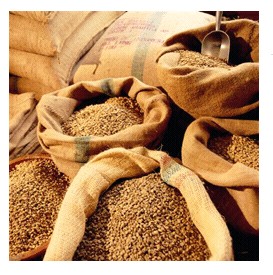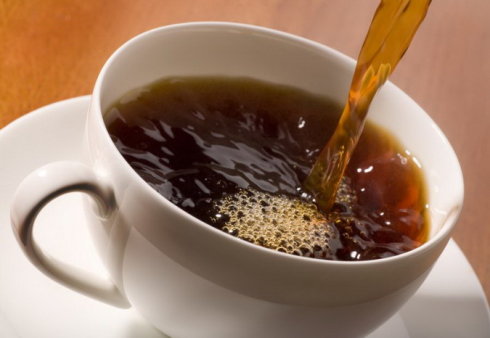World boutique Coffee Manor beans: Hawaiian Kona Coffee (part I) has a smooth and fragrant flavor
Some bloggers mentioned coffee grown in Hainan, China. As far as I know, Mr. Lin Wending, a Taiwanese businessman, has grown coffee in Hainan, created his own brands "Ancient Coffee" (homonym for English Good Sir) and "Qiangna Coffee" (homonym for Chinese China), and introduced Arabica varieties with high yield and disease resistance from Brazil. Hainan geological volcanic laterite is the same as the famous coffee product Kona coffee in Hawaii. It is hoped that famous products like Kona can be grown in the future. So today the world famous Coffee Tour series will introduce the famous coffee produced by Hawaii, the world's largest coffee consumer, the United States, and it is also the only coffee produced in the United States, Hawaii Kona Coffee.
Hawaiian Kona Coffee (Hawaii Kona Coffee)
[quality grading]: excellent (Extra Fancy)
[baking degree] medium-depth baking (High Roast or City Roast) is recommended.
[grade] excellent
[granule] ★★★★ is fuller
[acidity] ★★ microacid
[equilibrium] ★★★★ is relatively stable
[flavor] smooth, fragrant, with charming nutty aromas
[coffee producing areas]: Kona District, Hawaii (Hawaii Kona)
[raw bean treatment]: washing and refining method
Hawaiian Kona coffee is the only top variety produced in 50 states in the United States, and the United States is naturally its largest market. Kona coffee beans from Hawaii have the most perfect appearance. Their fruits are extremely full and shiny. They are the most beautiful coffee beans in the world. The coffee is smooth and fragrant, with an attractive nutty flavor and a well-balanced acidity, as charming as the colorful colors of the island of Hawaii and a long finish.
The world-famous "Kona of Hawaii" is a mellow and sour coffee bean. Kona coffee is grown on the slopes of Mauna Roa volcano on the southwest coast of Hawaii. In terms of flavor, Kona coffee beans are closer to Central American coffee than Indonesian coffee. Its average quality is very high, carefully handled, medium texture, good sour taste, very rich flavor, and fresh Kona coffee is extremely fragrant. If you think Indonesian coffee is too thick, African coffee is too sour, and Central and South American coffee is too rough, then "Kona" may be right for you. Kona is like a girl in the Hawaiian sunshine breeze, fresh and natural.
Kona coffee beans are average and neat in shape, with strong sour and sweet taste, moist and smooth taste. Because they grow on volcanoes and have high-density artificial farming, each bean can be said to be a spoiled "lady" with beautiful, plump and baby-like skin.
Although Hawaii is often affected by hurricanes, the climatic conditions are very suitable for the coffee industry. There is plenty of rain and sunshine, and there is no worry of frost. In addition, there is a strange natural phenomenon called "free shade". On most days, around 2 o'clock in the afternoon, white clouds appear in the sky, providing the necessary shade for the coffee trees. In fact, it is such superior natural conditions that make Arabica coffee in the Kona region produce more coffee per unit than any other plantation in the world, and always maintain high quality, unique growth and climate environment to create a stronger coffee flavor.
But to the regret of coffee fans, only about 1400 hectares of coffee is produced. And because of Hawaii's high income and a large number of tourists, Kona coffee is so expensive that it is even sold as "kona blend" (the actual content of Kona beans is no more than 5%). In recent years, neighboring islands such as maui, kauai and molokai have also begun to grow coffee commercially.
The real Hawaiian Kona coffee has the sweetness of caramel, which makes people enjoy the unique pleasure and leads you slowly into the detached state of tasting coffee. Of all the coffee producers, Hawaii has the most stringent management of the coffee industry, the highest labor costs and the best level of investment.
Hawaii's coffee industry has to compete with the expanding tourism industry. Most coffee is grown on the slopes of Mauna Loa. Mauna Loa was originally a volcano located in the western part of the Kona region on the island of Hawaii. The coffee producing area is about 30 kilometers long and its growing areas are mainly concentrated in the north and south of the area. Coffee trees are planted in relatively desolate areas, but their soil is fertile and contains volcanic ash. Although it takes a lot of physical labor to start planting and it is difficult to manage, it is comforting that Kona's coffee trees (at least those growing above 900 meters above sea level) do not seem to be affected by any diseases and insect pests.
You should know that the diseases and insect pests of coffee trees are very serious, especially a small coffee fruit borer called Coffee Berry borer. There is usually no other way to get rid of this disease and insect pests but to spray heavy pesticides, and people and animals are not allowed to enter within two weeks of each application, otherwise there is a risk of pesticide poisoning. Kona, Hawaii is blessed with no such pests, so it is naturally environmentally friendly and free of pesticide pollution.
Today, Kona Coffee is mainly produced in the southwest of Big Island, Hawaii, 20 miles long and 2 miles wide, covering the slopes of Hualalai and Mauna Loa. Only coffee beans grown in this area and subject to the most stringent certification standards can be sold under the trademark Kona. Today, about 100 farms have produced coffee beans that meet these standards, and more and more farms are expected to follow suit in the future. The Hawaiian islands have long been recognized as a paradise on earth, and after nearly two centuries of efforts to grow coffee, the term Kona kona is almost synonymous with quality. Now other Hawaiian islands are trying to catch up with the high quality standards of Kona kona. Now Hawaii is really like Mark to many beach activities and coffee lovers. Twain's image is generally the most enjoyable place on earth.
Real Kona coffee is indeed a treasure in the world, it is not easy to find, even in the United States, it is difficult to buy genuine coffee. The best Kona coffee is divided into three grades: Extra Fancy, Fancy and Number One. This third-class coffee is produced on manors and under natural conditions. Most of the coffee that calls itself "Kona" now contains less than 5% of the real Hawaiian Kona coffee. Another good Hawaiian coffee can be found in the United States-Hawaiian Kaj Farm Coffee (KaiFarms).
Source:
The blog of Mermaid Rock
Important Notice :
前街咖啡 FrontStreet Coffee has moved to new addredd:
FrontStreet Coffee Address: 315,Donghua East Road,GuangZhou
Tel:020 38364473
- Prev

World boutique coffee farm beans: full-bodied and lively movement of Mantenin in Sumatra, Indonesia
[product name] Sumatra Mandheling Coffee of Sumatra [quality rating]: DP Grade 1 [baking degree] recommended baking degree is moderate to deep baking (High Roast to Full-City Roast) [grade] excellent [granule] ★ very full [acidity] ★★ micro acid [balance] ★★ generally [flavor] contains chocolate flavor
- Next

World boutique coffee farm beans; Hawaiian Kona coffee (part two) has a charming nutty aroma
[product name] Hawaiian Kona Coffee (Hawaii Kona Coffee) [quality grading]: extra good (Extra Fancy) [roasting degree] it is recommended that deep roasting in roasting degree (High Roast or City Roast) [grade] excellent [granule] ★★★★ is fuller [acidity] ★★ micro acid [balance] ★★★★ is more stable [flavor] smooth, rich, mysterious.
Related
- Does Rose Summer choose Blue, Green or Red? Detailed explanation of Rose Summer Coffee plots and Classification in Panamanian Jade Manor
- What is the difference between the origin, producing area, processing plant, cooperative and manor of coffee beans?
- How fine does the espresso powder fit? how to grind the espresso?
- Sca coffee roasting degree color card coffee roasting degree 8 roasting color values what do you mean?
- The practice of lattes: how to make lattes at home
- Introduction to Indonesian Fine Coffee beans-- Java Coffee producing area of Indonesian Arabica Coffee
- How much will the flavor of light and medium roasted rose summer be expressed? What baking level is rose summer suitable for?
- Introduction to the characteristics of washing, sun-drying or wet-planing coffee commonly used in Mantenin, Indonesia
- Price characteristics of Arabica Coffee Bean Starbucks introduction to Manning Coffee Bean Taste producing area Variety Manor
- What is the authentic Yega flavor? What are the flavor characteristics of the really excellent Yejasuffi coffee beans?

